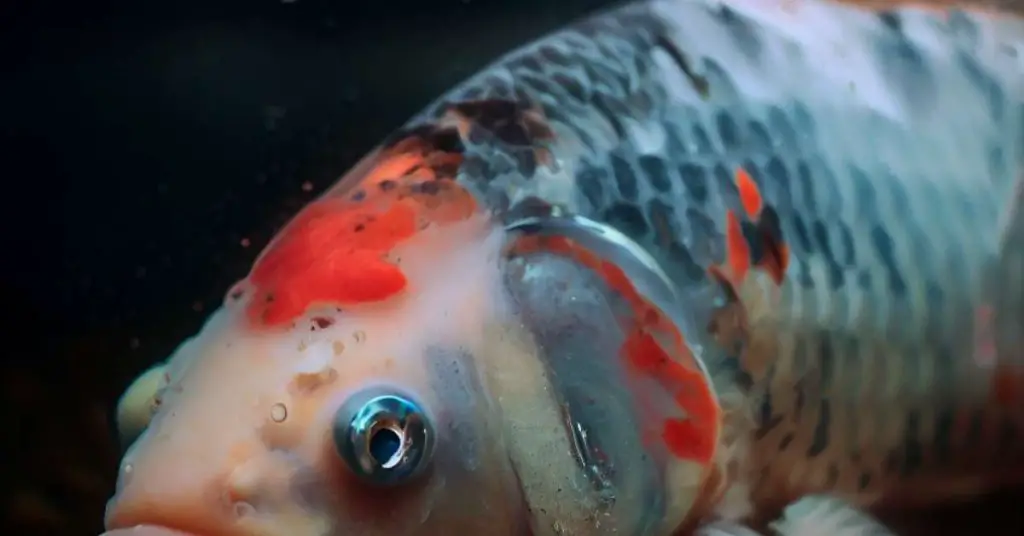Why Is My Koi Fish Flashing? What Koi Flashing Is, And How To Fix It
Flashing in koi fish refers to the act of rubbing, flicking, or banging their bodies against objects in the pond or tank. Koi fish usually show flashing behavior because of skin irritation or parasites, stress or environmental factors, or breeding and mating behavior. Identifying why your Koi is flashing requires a bit of knowledge and lots of observation.
When you notice your Koi fish is flashing, it’s crucial to address it right away by ensuring proper pond or tank maintenance, as well as maintaining good water quality. Treatment options are available for specific causes of flashing behavior, including addressing skin irritation or parasitic infestation and managing stress and environmental factors.
But in order to identify when you’re Koi is flashing, it’s important to understand it first. By following proper care and taking necessary measures, koi fish owners can ensure the comfort and health of their pets.

Understanding flashing behavior in koi fish
Flashing behavior in koi fish may seem odd, but it’s actually extremely common. So, what exactly is flashing? Well, it’s when your koi fish start rubbing or banging their bodies against objects in their pond or tank. It may look alarming, but there’s usually a reason behind this behavior.
A. Definition of flashing in koi fish
Before we dive into the reasons behind flashing behavior, let’s define what it actually means. When koi fish flash, they’re essentially trying to scratch an itch or get rid of something irritating on their bodies. It’s like when we humans scratch an itch on our skin, except koi fish can’t use their fins like we use our hands.
B. Reasons why koi fish exhibit flashing behavior
Now that we know what flashing is, let’s explore why koi fish engage in this behavior. There are several potential causes, so let’s break them down one by one.
- Skin irritation or parasites: Koi fish may flash if they have irritated skin or are plagued by parasites. It’s their way of trying to alleviate the discomfort. Just like how a mosquito bite can make us itch, these irritants can drive koi fish to flash.
- Stress or environmental factors: Koi fish are sensitive creatures, and stress can trigger flashing behavior. Factors like poor water quality, fluctuations in temperature, or overcrowding can all contribute to their stress levels.
- Breeding or mating behavior: Flashing can also be a normal part of the breeding process for koi fish. During mating season, males may display flashing behavior to attract females or establish dominance.
C. Common causes of flashing behavior in koi fish
| Cause | Description |
|---|---|
| Skin irritation or parasites | Irritated skin or presence of parasites can lead to flashing behavior as koi fish try to relieve discomfort. |
| Stress or environmental factors | Poor water quality, temperature fluctuations, or overcrowding can induce stress and trigger flashing behavior. |
| Breeding or mating behavior | Flashing may be a normal part of the mating process for koi fish, with males exhibiting the behavior to attract females or establish dominance. |
Assessing the health of koi fish
When it comes to keeping your beloved koi fish happy and healthy, it’s crucial to understand how to assess their overall well-being. By being aware of potential health issues and regularly monitoring their behavior, you can catch any problems early on and ensure they receive the proper care they need.
There are several signs that may indicate potential health issues in koi fish. Keep an eye out for abnormal behaviors such as lethargy, loss of appetite, or difficulty swimming. Physical symptoms like visible wounds, lesions, or discoloration on their skin can also be red flags.
Regular monitoring and observation of your koi fish is essential. Take the time to carefully observe their behavior on a daily basis. Are they swimming effortlessly? Are they interacting with their environment and other fish? These observations can provide valuable insights into their overall health.
Related Post: Related Post: Can koi fish actually recognize their owners?
Key indicators of a healthy koi fish
- Active and energetic swimming patterns
- Healthy appetite and eagerness to eat
- Bright and vibrant colors
- Clear and undamaged skin and fins
- Smooth movements without any sign of discomfort
These indicators can serve as a guide for assessing your koi fish’s health. By keeping an eye out for any deviations from these normal signs, you can quickly identify any potential issues that may require attention.
Remember, the best way to avoid your Koi getting sick is to only purchase from reputable Koi farms, some of which are available online and deliver right to your home.
Potential dangers of Koi flashing behavior
- Koi fish flashing may seem like harmless behavior, but it can actually pose various dangers to the health and well-being of your beloved fish. One major risk is the potential for injury or physical damage to the koi fish.
- When koi fish repeatedly rub or bang their bodies against objects in the pond or tank, they can easily cause scrapes, cuts, or bruises. These wounds can become infected and lead to more serious health issues if left untreated.
- In addition to the direct harm to the flashing fish, this behavior can also have an impact on the overall ecosystem of your pond or tank. The constant agitation and disturbance caused by flashing can stress out other fish in the vicinity.
- This stress can weaken their immune system and make them more susceptible to diseases and infections. It may also disrupt their feeding and breeding patterns, leading to further health complications.
- Furthermore, flashing behavior can have a negative effect on the well-being of other fish in the pond or tank. The forceful rubbing or banging can dislodge scales or fins, affecting the appearance and functionality of these body parts.
- This not only diminishes the beauty of the fish, but it can also impair their ability to swim and engage in normal activities. It’s important to monitor the behavior of all fish in the pond or tank to ensure their overall health and happiness.

Diagnosing the cause of flashing behavior
Diagnosing the cause of flashing behavior in koi fish can be a crucial step in determining the appropriate treatment or preventive measures to take. By identifying the underlying cause, you can address the root of the issue and help your koi fish return to a calmer and healthier state.
So, how can you go about diagnosing the cause of flashing behavior in your koi fish? First and foremost, it’s important to carefully observe and monitor their behavior. Notice any patterns or triggers that seem to provoke the flashing behavior. Keep track of the time of day, the water temperature, and any recent changes in the environment or their diet.
Additionally, consulting with a professional or experienced veterinarian can be incredibly helpful. They have the expertise and knowledge to guide you through the diagnostic process and provide recommendations on the best course of action. Be sure to find a veterinarian who specializes in fish or aquatic animals, as they will have specific insights into koi fish health and behavior.
Diagnostic tests and examinations to determine the cause of flashing behavior
- Water quality testing: Assessing the pH levels, ammonia and nitrate levels, and overall water chemistry can help identify if poor water quality is behind the flashing behavior.
- Physical examination: A veterinarian may conduct a thorough physical examination of your koi fish to check for signs of skin irritation, lesions, or physical abnormalities.
- Microscopic examination: Collecting skin mucus or gill samples and analyzing them under a microscope can reveal the presence of parasites or infections.
- Biopsy: In some cases, a small tissue sample may need to be taken from the affected area for further examination and analysis to determine the cause of flashing behavior.
Remember, diagnosing the cause of flashing behavior may require a combination of these tests or even additional specialized tests. The goal is to gather as much information as possible to make an accurate diagnosis and provide targeted treatment or preventive measures.
Solutions and preventive measures
A. Addressing common triggers and stressors
When it comes to helping your koi fish overcome flashing behavior, it’s important to address any common triggers or stressors that may be causing them distress. Check the water temperature and ensure it’s within the suitable range for koi fish. Fluctuations in temperature can cause stress, so consider using a heater or chiller to maintain a stable environment. Additionally, make sure your koi fish have enough space in the pond or tank. Overcrowding can increase stress levels, so consider rehoming some fish if necessary.
B. Proper pond or tank maintenance and water quality
Maintaining a clean and healthy environment is essential for the well-being of your koi fish. Regularly clean the pond or tank, removing any debris or algae buildup. This will help prevent skin irritation and create a healthier living space for your fish. Monitoring and maintaining good water quality is crucial as well. Test the water regularly for parameters such as ammonia, nitrite, nitrate, and pH levels. Ensure these levels are within the appropriate range for koi fish and take necessary steps to correct any imbalances.
C. List: Strategies to prevent or minimize flashing behavior
- Provide hiding spots or shelters for your koi fish. This can help reduce stress levels and give them a sense of security.
- Avoid sudden changes in the pond or tank environment, such as sudden water changes or adding new fish. Gradual transitions are less likely to induce flashing behavior.
- Implement a regular feeding schedule and provide a balanced diet for your koi fish. Proper nutrition can contribute to overall health and reduce the likelihood of skin irritation.
- Install a UV sterilizer or use proper filtration systems to minimize the presence of harmful organisms in the water.
- Avoid using chemicals or treatments that may be harmful to your fish. Always research and consult a professional before introducing any new products to the pond or tank.
- Ensure proper aeration and circulation in the pond or tank. This will help maintain oxygen levels and create a more comfortable environment for your koi fish.
Specific treatments for flashing behavior causes
A. Treating skin irritation and parasitic infestation
Skin irritation and parasitic infestation are common causes of flashing behavior in koi fish. These issues can be addressed through various treatments. One effective method is using a water conditioner specifically designed to treat parasite infestations. These conditioners can help eliminate parasites while also soothing the fish’s irritated skin.
If the flashing behavior is caused by skin irritation, you may need to examine the water quality in your pond or tank. Sometimes, poor water conditions can lead to skin problems in koi fish. Ensure that the pH level and ammonia levels are within the appropriate range. Adding a pond salt or other fish-friendly supplements can also help maintain healthy skin and minimize irritation.
B. Managing stress and environmental factors
Stress and environmental factors can also trigger flashing behavior in koi fish. To address these causes, it’s crucial to create a calm and comfortable environment for your fish. Providing adequate hiding spots, such as rocks or plants, can help reduce stress levels. Additionally, ensure that the water temperature is appropriate for your koi fish species and maintain stable water conditions.
Adding natural stress-reducing agents, like Indian almond leaves or stress coat additives, can also help alleviate stress in your fish. These natural remedies can create a more relaxing environment, reducing the likelihood of flashing behavior.
C. List: Treatment options for common causes of flashing behavior
- For skin irritation or parasites:
- Use a water conditioner designed to treat parasites
- Check water quality and adjust pH and ammonia levels
- Add pond salt or supplements for healthy skin
- For stress or environmental factors:
- Create a calm and comfortable environment with hiding spots
- Maintain appropriate water temperature and stable water conditions
- Add natural stress-reducing agents like Indian almond leaves or stress coat additives
Treating the underlying causes of flashing behavior in koi fish is essential for their well-being. By following these treatment options, you can help your fish overcome skin issues, parasites, stress, and environmental factors. Remember to always consult with a professional or veterinarian for further guidance and assistance.
Conclusion
In this article, we explored the phenomenon of flashing behavior in koi fish and why it occurs. We discussed the different reasons why koi fish engage in flashing, including skin irritation or parasites, stress or environmental factors, and breeding or mating behavior. We also highlighted the importance of assessing the health of koi fish regularly and understanding the potential dangers of flashing behavior.
Diagnosing the cause of flashing behavior can be a challenging task, but there are recommended steps and diagnostic tests that can help identify the underlying issue. Once the cause is identified, there are various solutions and preventive measures that can be implemented to address flashing behavior in koi fish. Additionally, we provided specific treatments for common causes, such as treating skin irritation and managing stress and environmental factors.
To summarize the main points discussed in this article:
- Flashing behavior in koi fish refers to the act of rubbing or banging their bodies against objects in the pond or tank.
- Common causes of flashing behavior include skin irritation or parasites, stress or environmental factors, and breeding or mating behavior.
- Regular monitoring and observation are important in assessing the health of koi fish.
- Flashing behavior can pose risks to the health and well-being of koi fish and the overall pond or tank ecosystem.
- Identifying the underlying cause of flashing behavior may require professional consultation and diagnostic tests.
- Preventive measures and addressing triggers can help minimize flashing behavior.
- Treatments for flashing behavior causes include addressing skin irritation, managing stress, and environmental factors.
We hope this article has provided you with valuable insights into the world of flashing behavior in koi fish and equipped you with the knowledge to take the appropriate actions needed to ensure the health and well-being of your beloved aquatic pets.
Related Questions
Can flashing behavior cause harm to my koi fish?
Yes, flashing behavior can potentially harm your koi fish. It can lead to injuries and physical damage, such as scrapes or bruises, especially if they rub against sharp objects. It is crucial to address the underlying cause of flashing behavior to ensure the well-being of your koi fish.
How can I prevent flashing behavior in my koi fish?
Preventing flashing behavior in koi fish requires addressing potential triggers and stressors. Proper pond or tank maintenance, including regular cleaning and monitoring of water quality, can help minimize skin irritations and parasites. Providing a stress-free environment with adequate hiding spots and suitable water conditions can also help reduce instances of flashing behavior.







